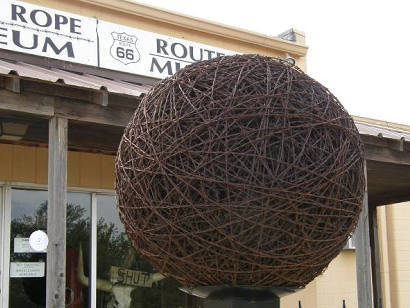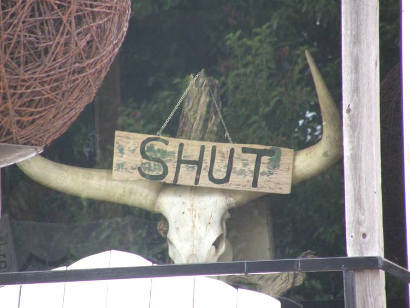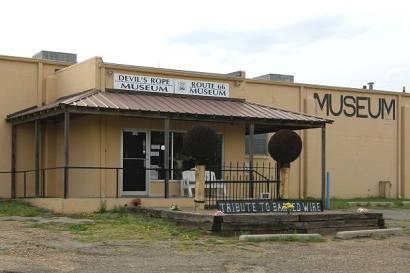Devil's Rope Museum, the Tribute to Barbed Wire. (original) (raw)
Imagine two huge solid barbed wire balls weighing approximately 400 pounds each, sitting atop limestone rock fenceposts and joined by antique wrought iron fencing. This unique monument is the creation of Frank and Violet Smith of Keller, Texas. The Smiths are charter members of the Devil's Rope Museum of McLean, Texas, and the museum, known as the largest barbed wire museum in the world, features this "Tribute to Barbed Wire" monument at the front entrance. It has been photographed by more than 85,000 visitors since 1992.
 |
The "TRIBUTE TO BARBED WIRE" The Only Monument in the World dedicated to Barbed Wire Photo courtesy TXDoT |
|---|
 |
Devil's Rope Museum Interior Photo courtesy TXDoT |
|---|
The Smith's used it as a yard ornament and nameplate for their home in Keller, Texas for many years as they were avid collectors of barbed wire and other memorabilia. They donated the monument to the museum in 1992 and it was moved and erected permanently at the present site.
Historians state that, "Barbed wire gave us control of the land, and windmills made the land habitable." Barbed wire was chosen as one of the most significant patents to come out of the Industrial Revolution. Collectors say, "Get Hooked, on collecting barbed wire."
�
Delbert Trew "It's All Trew" March 24, 2004 column


Recent Acquisitions:
Photos serve as reminder of boundaries' importance
by Delbert Trew
In our modern times when eminent domain and development arrogance often dominate the evening news, we received the story and photos of John Prather, a rancher who lived in Otero County, N.M. Prather garnered national attention in the 1950s by taking a heroic stand against the U.S. government's attempt to condemn his ranch in order to add it to the nearby McGregor Missile Range, a part of Fort Bliss, near El Paso.
Although the Devil's Rope Museum in McLean has a huge library about barbed wire, some 6,000 related artifacts and a section dedicated to ranches and brands, we still welcome true stories about the uses and history of these subjects.
The story of John Prather fit our requirements as it told of early-day fence building, the importance of defining our boundaries and protecting our right to own land until death, if need be.
The package contained photos and published documents plus eight livestock brands used by the family, all registered with the New Mexico State Brand Records dating from 1888 to modern times. A special display has been constructed to house and show this information....

Barbed Wire Fences Related Articles:
- Digging post holes by hand was hard work by Delbert Trew
Among the hundreds of jobs associated with farming and ranching, digging postholes by hand is by far my least favorite. Today, most postholes are dug by equipment powered by tractors, motors and hydraulics. Iron tee posts driven into the ground have pretty well replaced the need for digging post holes. But not so long ago all postholes were dug by hand with a pair of diggers.
Of interest is the fact the Devil's Rope Museum in McLean has approximately 60 patented post hole diggers on display all showing different designs and mechanisms to make the job easier. more - Barbed Wires called Devil's Rope for a Reason by Delbert Trew
- Barbed Wire Telephones by Delbert Trew
- Barbed Wire Fences by C. F. Eckhardt
- Phone Fear by Mike Cox
